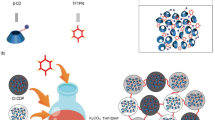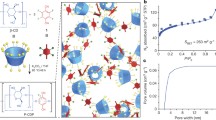Abstract
As one group of important naphthalene derivatives, naphthol and naphthylamine are diffusely employed as dye intermediates. The presence of naphthol and naphthylamine in water systems may pose risks to the environment and public health due to their carcinogenicity. In this study, four mesoporous polymers prepared by β-cyclodextrin derivatives and tetrafluoroterephthalonitrile were obtained and applied to adsorbing 1-naphthylamine, 2-naphthylamine, 1-naphthol, and 2-naphthol from water. The impact of adsorption time, initial concentration of naphthol and naphthylamine, and temperature on the adsorption efficiency of the four polymers were explored separately. The four polymers present fast adsorption kinetics toward naphthol and naphthylamine, attaining 93 ~ 100% of adsorption equilibrium uptake for 1-naphthol, 1-naphthylamine, 2-naphthylamine in 15 min, and 87 ~ 90% of equilibrium uptake for 2-naphthol in 15 min. The kinetics could be depicted well by the pseudo-second-order kinetic model. The adsorption isotherms of the four polymers toward naphthol and naphthylamine accord with the Redlich-Peterson or Sips model. The maximum adsorption capacities of 1-naphthylamine, 2-naphthylamine, 1-naphthol, and 2-naphthol are 189.9 mg/g, 82.8 mg/g, 137.7 mg/g, and 88.7 mg/g, respectively. The adsorption ratio increases fast with reducing the initial concentration of naphthol and naphthylamine, and the adsorption ratio of naphthol and naphthylamine in 5 mg/L can achieve over 95% in 25 °C. In addition, the four polymers can be effortlessly regenerated by a gentle and simple washing procedure with little reduction in performance. The adsorption performance of the four polymers toward the four naphthalene derivatives can be improved by increasing the adsorption temperature. In conclusion, the prepared β-cyclodextrin polymers exhibit rapid water treatment in removing the four low-concentration naphthalene derivatives with convenient regeneration and good reusability.










Similar content being viewed by others
Data availability
All data generated or analyzed during this study are included in this published article.
References
Alsbaiee A, Smith BJ, Xiao LL, Ling YH, Helbling DE, Dichtel WR (2016) Rapid removal of organic micropollutants from water by a porous β-cyclodextrin polymer. Nature 529:190–194. https://doi.org/10.1038/nature16185
Alzate-Sánchez DM, Ling Y, Li C, Frank BP, Bleher R, Fairbrother DH, Helbling DE, Dichtel WR (2019) β-Cyclodextrin polymers on microcrystalline cellulose as a granular media for organic micropollutant removal from water. ACS Appl Mater Interfaces 11:8089–8096. https://doi.org/10.1021/acsami.8b22100
Connors KA (1997) The stability of cyclodextrin complexes in solution. Chem Rev 97:1325–1357. https://doi.org/10.1021/cr960371r
Cova TF, Murtinho D, Aguado R, Pais AACC, Valente AJM (2021) Cyclodextrin polymers and cyclodextrin-containing polysaccharides for water remediation. Polysaccharides 2:16–38. https://doi.org/10.3390/polysaccharides2010002
Crini G, Morcellet M (2002) Synthesis and applications of adsorbents containing cyclodextrins. J Sep Sci 25:789–813. https://doi.org/10.1002/1615-9314(20020901)25:13%3c789::AID-JSSC789%3e3.0.CO;2-J
Czubacka E, Czerczak S (2020) 2-naphthylamine toxicity. Med Pr 71:205–220. https://doi.org/10.13075/mp.5893.00921
Dias A, Ciminelli VST (2000) Analysis of nitrogen adsorption-desorption isotherms for the estimation of pore-network dimensions and structure of ferroelectric powders. Ferroelectrics 241(1):9–16. https://doi.org/10.1080/00150190008224969
Duan Z, Li Y, Zhang M, Bian H, Wang Y, Zhu L (2020) Towards cleaner wastewater treatment for special removal of cationic organic dye pollutants: a case study on application of supramolecular inclusion technology with β-cyclodextrin derivatives. J Clean Prod 256:120308. https://doi.org/10.1016/j.jclepro.2020.120308
Foo KY, Hameed BH (2010) Insights into the modeling of adsorption isotherm systems. Chem Eng J 156:2–10. https://doi.org/10.1016/j.cej.2009.09.013
Gu T, Tsai GJ, Tsao GT (2006) Synthesis of rigid cyclodextrin-containing polymeric resins for adsorption. J Incl Phenom Macro 56:375–379. https://doi.org/10.1007/s10847-006-9119-9
Hamed MM (2014) Sorbent extraction behavior of a nonionic surfactant, Triton X-100, onto commercial charcoal from low level radioactive waste. J Radioanal Nucl Chem 302(1):303–313. https://doi.org/10.1007/s10967-014-3250-7
Hamed MM, Holiel M, Ismail ZH (2016) Removal of 134Cs and 152+154Eu from liquid radioactive waste using Dowex HCR-S/S. Radiochim Acta 104(6):399–413. https://doi.org/10.1515/ract-2015-2514
Haritash AK, Kaushik CP (2009) Biodegradation aspects of polycyclic aromatic hydrocarbons (PAHs): a review. J Hazard Mater 169:1–15. https://doi.org/10.1016/J.JHAZMAT.2009.03.137
Ho YS (2006) Review of second-order models for adsorption systems. J Hazard Mater 136:681–689. https://doi.org/10.1016/j.jhazmat.2005.12.043
Hou L, Zhu D, Wang X, Wang L, Zhang C, Chen W (2013) Adsorption of phenanthrene, 2-naphthol, and 1-naphthylamine to colloidal oxidized multiwalled carbon nanotubes: effects of humic acid and surfactant modification. Environ Toxicol Chem 32(3):493–500. https://doi.org/10.1002/etc.2088
Hu J, Shao D, Chen C, Sheng G, Ren X, Wang X (2011) Removal of 1-naphthylamine from aqueous solution by multiwall carbon nanotubes/iron oxides/cyclodextrin composite. J Hazard Mater 185:463–471. https://doi.org/10.1016/j.jhazmat.2010.09.055
Hu C, Xu W, Li H, Zhou S, Mo X, Zhang P, Tang K (2019) Highly efficient adsorption of Au(III) from water by a novel metal–organic framework constructed with sulfur-containing ligands and Zn(II). Ind Eng Chem Res 58:17972–17979. https://doi.org/10.1021/acs.iecr.9b03433
Hu X, Xu G, Zhang H, Li M, Tu Y, Xie X, Zhu Y, Jiang L, Zhu X, Ji X, Ya Li, Li A (2020) Multifunctional β-cyclodextrin polymer for simultaneous removal of natural organic matter and organic micropollutants and detrimental microorganisms from water. ACS Appl Mater Interfaces 12:12165–12175. https://doi.org/10.1021/acsami.0c00597
Li DQ, Ma M (1999) Nanoporous polymers: new nanosponge absorbent media. Filtr Sep 36:26–28. https://doi.org/10.1016/S0015-1882(00)80050-6
Li YC, Tian HY, Xiao CS, Ding JX, Chen XS (2014) Efficient recovery of precious metal based on Au–S bond and electrostatic interaction. Green Chem 16:4875. https://doi.org/10.1039/c4gc01375a
Lin DH, Xing BS (2008) Adsorption of phenolic compounds by carbon nanotubes: Role of aromaticity and substitution of hydroxyl groups. Environ Sci Technol 42:7254–7259. https://doi.org/10.1021/es801297u
Ling Y, Klemes MJ, Xiao L, Alsbaiee A, Dichtel WR, Helbling DE (2017) Benchmarking micropollutant removal by activated carbon and porous β-cyclodextrin polymers under environmentally relevant scenarios. Environ Sci Technol 51:7590–7598. https://doi.org/10.1021/acs.est.7b00906
Lu P, Cheng J, Li Y, Wang Q, He C (2019) Novel porous β-cyclodextrin/pillar[5]arene copolymer for rapid removal of organic pollutants from water. Carbohyd Polym 216:149–156. https://doi.org/10.1016/j.carbpol.2019.04.015
Mhlanga SD, Mamba BB, Krause RW, Malefetse TJ (2007) Removal of organic contaminants from water using nanosponge cyclodextrin polyurethanes. J Chem Technol Biot 82:382–388. https://doi.org/10.1002/jctb.1681
Morin-Crini NMC, Grégorio C (2013) Environmental applications of water-insoluble β-cyclodextrin–epichlorohydrin polymers. Prog Polym Sci 38:344–368. https://doi.org/10.1016/j.progpolymsci.2012.06.005
Rebekah A, Bharath G, Naushad Mu, Viswanathan C, Ponpandian N (2020) Magnetic graphene/chitosan nanocomposite: a promising nanoadsorbent for the removal of 2-naphthol from aqueous solution and their kinetic studies. Int J Biol Macromol 159:530–538. https://doi.org/10.1016/j.ijbiomac.2020.05.113
Rizk SE, Hamed MM (2015) Batch sorption of iron complex dye, naphthol green b, from wastewater on charcoal, kaolinite, and tafla. Desalin Water Treat 56(6):1536–1546. https://doi.org/10.1080/19443994.2014.954004
Simonin JP (2016) On the comparison of pseudo-first order and pseudo-second order rate laws in the modeling of adsorption kinetics. Chem Eng J 300:254–263. https://doi.org/10.1016/j.cej.2016.04.079
Tian B, Liu J (2020) The classification and application of cyclodextrin polymers: a review. New J Chem 44:9137–9148. https://doi.org/10.1039/C9NJ05844C
Wang J, Harrison M (2018) Removal of organic micro-pollutants from water by β-cyclodextrin triazine polymers. J Incl Phenom Macro Chem 92:347–356. https://doi.org/10.1007/s10847-018-0851-8
Wilson LD, Mohamed MH, Headley JV (2011) Surface area and pore structure properties of urethane-based copolymers containing β-cyclodextrin. J Colloid Interf Sci 357:215–222. https://doi.org/10.1016/j.jcis.2011.01.081
Xie ZW, Lin JC, Xu MY, Wang HY, Jiang H (2020) Novel Fe3O4 nanoparticle/β-cyclodextrin-based polymer composites for removal of methylene blue from water. Ind Eng Chem Res 59(26):12270–12281. https://doi.org/10.1021/acs.iecr.0c01115
Xu Z, Zhang Q, Wu C, Wang L (1997) Adsorption of naphthalene derivatives on different macroporous polymeric adsorbents. Chemosphere 35:2269–2276. https://doi.org/10.1016/S0045-6535(97)00305-6
Yang Z, Zhang Y, Wang X, Tian Z, Yang W, Graham NJD (2020) Efficient adsorption of four phenolic compounds using a robust nanocomposite fabricated by confining 2D porous organic polymers in 3D anion exchangers. Chem Eng J 396:125296. https://doi.org/10.1016/j.cej.2020.125296
Yang Y, Pei Z, Yan L, Ma J, Zhang Z, Li Y, Yang R, Wang P, Zhu Y, Zhang Q (2021) Oxidative transformation of 1-naphthylamine in water mediated by different environmental black carbons. J Hazard Mater 403:123594. https://doi.org/10.1016/j.jhazmat.2020.123594
Zhang W, Hong C, Pan B, Xu Z, Zhang Q, Lv L (2008) Removal enhancement of 1-naphthol and 1-naphthylamine in single and binary aqueous phase by acid-basic interactions with polymer adsorbents. J Hazard Mater 158:293–299. https://doi.org/10.1016/j.jhazmat.2008.01.079
Zhang T, Li C, Sun X, Gao H, Liu X, Sun J, Shi W, Ai S (2020) Iron nanoparticles encapsulated within nitrogen and sulfur co-doped magnetic porous carbon as an efficient peroxymonosulfate activator to degrade 1-naphthol. Sci Total Environ 739:139896. https://doi.org/10.1016/j.scitotenv.2020.139896
Zhao F, Repo E, Yin D, Chen L, Kalliola S, Tang J, Iakovleva E, Tam KC, Sillanpää M (2017) One-pot synthesis of trifunctional chitosan-EDTA-β-cyclodextrin polymer for simultaneous removal of metals and organic micropollutants. Sci Rep 7:15811. https://doi.org/10.1038/s41598-017-16222-7
Zhou Q, Wang Y, Xiao J, Fan H (2016) Adsorption and removal of bisphenol a, α-naphthol and β-naphthol from aqueous solution by Fe3O4@polyaniline core-shell nanomaterials. Synthetic Met 212:113–122. https://doi.org/10.1016/j.synthmet.2015.12.008
Zhou S, Xu W, Hu C, Zhang P, Tang K (2020) Fast and effective recovery of Au(III) from aqueous solution by a N containing polymer. Chemosphere 260:127615. https://doi.org/10.1016/j.chemosphere.2020.127615
Funding
This work was supported by the National Natural Science Foundation of China (grant number 21908050), the Natural Science Foundation of Hunan Province of China (grant number 2018JJ3209), and the Education Department of Hunan Province of China (grant number 19K038).
Author information
Authors and Affiliations
Contributions
Weifeng Xu: Conceptualization, methodology, project administration, writing—review and editing, funding acquisition.
Xiang Liu: Investigation, data curation, writing—original draft.
Jianzhe Cai: Investigation, data curation, formal analysis.
Tiemeng Xue: Validation.
Kewen Tang: Conceptualization, methodology, project administration.
Corresponding author
Ethics declarations
Ethics approval and consent to participate
Not applicable.
Consent for publication
Not applicable.
Conflict of interest
The authors declare no competing interests.
Additional information
Responsible Editor: Angeles Blanco
Publisher's note
Springer Nature remains neutral with regard to jurisdictional claims in published maps and institutional affiliations.
Rights and permissions
About this article
Cite this article
Xu, W., Liu, X., Cai, J. et al. Synthesis of reusable cyclodextrin polymers for removal of naphthol and naphthylamine from water. Environ Sci Pollut Res 29, 22106–22121 (2022). https://doi.org/10.1007/s11356-021-17234-7
Received:
Accepted:
Published:
Issue Date:
DOI: https://doi.org/10.1007/s11356-021-17234-7




